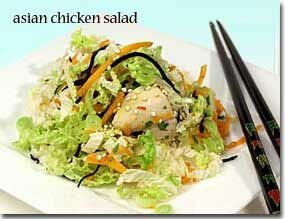If you don't know what to serve for dinner tonight ...
Avoid dry chicken breasts by using our Quick Broil cooking method — it's a great way to retain the moisture and flavor of chicken when you want to include it as part of your Healthiest Way of Eating. Enjoy this tasty recipe and the health benefits that come from it's wealth of health-promoting nutrients.

Prep and Cook Time: 30 minutes
Ingredients:
- 2 boneless chicken breasts, skin on
- 5 cups Chinese cabbage, sliced thin
- 1/2 cup shredded carrot
- 1/2 cup minced scallion
- 1/2 cup sliced almonds
- 1/4 cup chopped fresh cilantro
- 2 TBS toasted sesame seeds
- Optional: 2 TBS dried hijiki or arame seaweed, soaked in 1 cup warm water and chopped*
- Dressing
- 2 TBS extra olive oil
- 2 TBS soy sauce
- 1/4 cup rice vinegar
- 3 TBS honey
- pinch red pepper flakes
- salt & white pepper to taste
- *The safety factors regarding sea vegetables, such as hijiki
- Preheat broiler. Place a stainless steel (be sure the handle is also stainless steel) or cast iron skillet in the broiler, about 7 inches from the heat source, to get it very hot. Season chicken with a little salt and pepper.
- If you are using hijiki or arame place it in a small bowl of hot water to soften for about 10 minutes.
- While pan is heating, thinly slice cabbage, and shred carrot. Carrot is easily shredded in food processor with shredding blade. Otherwise you can shred it by hand, or slice it thin. Chop cilantro and scallion cabbage and carrot mixture. Add sliced almonds. Squeeze excess water from hijiki, chop if needed, and add to salad.
- When pan is hot, about 10 minutes, remove from broiler, and place chicken in pan, skin side up, and return to broiler. Cook for about 15 minutes depending on thickness of chicken. This is our Quick Broil cooking method. When done and cool enough to touch, remove skin, and cut into bite-size pieces.
- Whisk together olive oil, soy sauce, rice vinegar, honey, red pepper flakes, salt, and pepper. Toss with cabbage mixture and chicken. Sprinkle with sesame seeds. (You can buy sesame seeds that are already toasted.)
In-Depth Nutritional Profile for Asian Chicken Salad
Healthy Food Tip
What's the best way to benefit from olives in my Healthiest Way of Eating?
If you think you're getting the full benefits of olives by including a little olive oil in your salad dressing, think again. Researchers in Heidelberg, Germany have looked at all different types and forms of olives — including black olives, green olives, extra virgin olive oil, and refined virgin olive oil — and brining processes used in the olive industry, and their results tell us that there are even more potential health benefits in olives than previously thought.
But to get all of these health benefits, you'll probably need to expand the forms and types of olives that you include in your Healthiest Way of Eating. For example, suppose you've been a devoted fan of green olives, but you have never ventured out into the black olive category. In this case, you are missing out on the type of whole olive with the greatest concentration of phenolic antioxidants and the greatest antioxidant capacity! Including some black olives in your Healthiest Way of Eating is going to increase your health benefits in this regard.
Or suppose that you only eat whole olives, and you have traditionally considered olive oil to be of little value when it comes to health. In this case, you're missing out on some particular antioxidants (like secoiridoids and lignans) that are especially concentrated in the oil. You're going to need the oil to get these special health benefits. And you won't be able to settle for refined virgin olive oil, either. By insisting on extra virgin olive oil, you'll be doubling or tripling your intake of these unique antioxidants! (Since the processing of olives into oils can concentrate the olives' fat, it can also concentrate some of their fat-soluble nutrients. In addition, certain steps in the production process allow nutrients in different parts of the olive to combine with the oil, once again allowing olive oil to become more concentrated in certain nutrients.)
The olives you might want to focus less attention on are those prepared using the Spanish brining process. According to the research results of this study, this process seemed to take too great a toll on some of the phenolic antioxidants found in olives.
What potential health benefits might be associated with a greater emphasis on consuming extra virgin olive oil and an array of different types of olives? Researchers in this study concluded that olive oil and olives were very likely to be an even greater reason for the cancer-protective effects of the Mediterranean diet than previously suspected — and more specifically, more important for protection against breast and colorectal cancer, and in a somewhat surprising finding, against skin cancer as well.

No comments:
Post a Comment